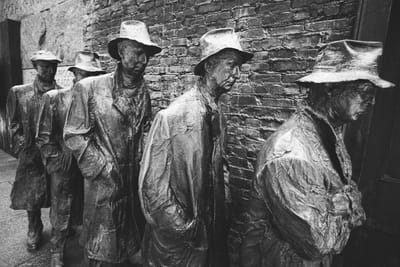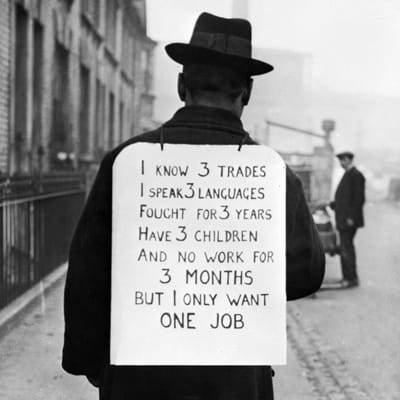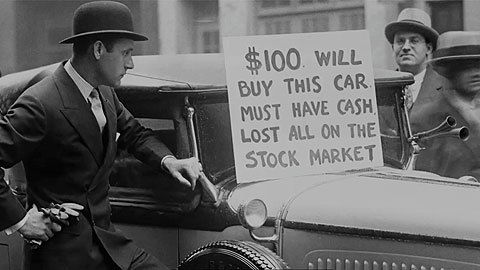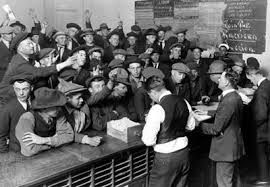The Great Depression
1929 - 1939
Quincy McKay, Jade Taylor, Logan Wilson, Alden Jones
Causes


 What Was It
What Was ItThe Great Depression was an unfortunate time for civilians in the 1930’s, which caused many people to go homeless and to have no jobs for a long period of time. As to why the great depression happened many people think it’s because of the Hawley-Smoot Tariff act which raised U.S. tariffs on over 20,000 imported goods. But this wasn’t the cause of the Great Depression, the crash of the Stock Market which is known as Black Tuesday(October 29, 1929) was.
Crashed
The Stock Market started to crash Monday October 28, 1929 due to the stock prices falling and collapsing, making the company go into a free fall. Billions of dollars went lost, wiping out loads of investors, and stock tickets ran very slow because the machinery couldn’t handle the tremendous volume of trading. October 29, 1929 prices went up a lot that day, which made it seem like there could be a considerable discovery in two weeks or less. But the stocks went back down due to the United States transitioning into “The Great Depression.”
Theories
Many people believed that the Hawley-Smoot Tariff act was a major reason of “The Great Depression” because the act was created to raise U.S. tariffs on over 20,000 imported goods. The act could’ve caused the depression because it increased the price of foreign goods and services purchased from overseas. The act was created by Senator Reed Smoot and representative Willis C. Hawley. Although many believed that the Hawley-Smoot Taruff act wasn’t a major reason of “The Great Depression” due to it being signed into law on June 17,1930.
Effects
Length- The Great Depression lasted a long amount of time it started in 1929 and nothing tried to stop it until 1937 with the new deal at the time our president was Herbert Hoover was trying hard to help the Great Depression he built the Hoover Dam also unemployment was skyrocketed during the time and needed to change Unemployment-

Unemployment- The highest rate of U.S. unemployment was 24.9 percent in 1933. That was during the Great Depression. Unemployment was more than 14 percent from 1931 to 1940. Unemployment remained in the single digits until 1982 when it reached 10.8 percent. This was bad times dads trying to provide for family’s couldn’t do it cause there work couldn’t take them.
Banks- banks began to fail at alarming rates. During the 20s, there was an average of 70 banks failing each year nationally. After the crash during the first 10 months of 1930, 744 banks failed 10 times as many. Banks were huge for farmers who wanted to spend but during this time they could not cause the banks had no money to lend.
Lifestyle
Intro
Above is a motto many U.S. families had to live by during the Great Depression. At first people pretended everything was okay even thought they had to wear ragged clothes and ration their food. Heads of housholds were being layed off left and right because the businesses they were working for could not afford them.
Food
Because of the lack of food during this time, people had to start their own gardens rather that paying for food at the grocery store. Pot lucks were a common occurrence, set up by churches and able to feed a significant amount of people. They also served as a free form of entertainment. As another solution to the food shortage, people would start thrift gardens in open, empty lots to share with their community. In Detroit, the thrift garden feed over 20,000 citizens. Magazines and radio shows helped teach homemakers how to ration out their food by making casseroles and one-pot meals.
Entertainment
At the time of the Great Depression, entertainment played a huge role. Games like Monopoly and Scrabble came out. Mini Golf had also taken America by storm. Over 30,000 locations opened during the 1920s. A reason that this might have occurred is that people, stopped going to the movies because they could no longer afford it. After all, a round was the cheap price of 25 to 50 cents. Another form of entertainment was listening to the radio. On the radio, soap operas, sports, and music served as a distraction.from peoples poor lifestyles.
Money
Because money was needed so badly, women started to enter the workforce. Of course, women were scrutinized for “stealing” jobs but, usually they were only hired for service jobs. That kind of work was reserved for women anyway at the time. Women also suffered mistreatment and discrimination. For example, men were commonly payed much more than women, a problem we still have in society today. Other than working, government aid served as another source of income. As common as it was, it was still severly frowned apon. Even though many people were ashamed, it was the New Deal that brought Americans out of the Great Depression.
For more information about the Great Depression, below is a BrainPOP.
BrainPOP
New Deal



The New Deal was a program with many series that helped end the Great Depression, and prevent future depressions. The New Deal was made to help with Relief, Recovery, and Reform. The New Deal was created by Congress in 1933 and passed by Franklin Delano Roosevelt in 1935. Franklin Roosevelt was the 32nd president of the United States. He was elected as president in 1933, and left office in 1945, at the end of World War 2.
The New Deal was composed of dozens of programs, that were released in three separate waves. The 1st wave (Relief) was passed by Congress in 1933, but it didn’t help end the Great Depression. The 2nd wave (Recovery) was passed by Franklin Roosevelt in 1935. This wave was made to improve the use of national resources, give security against old age, and help the unemployed and ill. The 2nd wave, was the first wave that actually helped end some of America’s problems at the time. Some of these popular programs include the Works Progress Administration, and the National Work Relief Program. Finally, the 3rd wave (Reform) was passed in 1937, and helped prevent another Great Depression. This wave was made to finalize the leftover problems in America, and make sure they wouldn’t happen again.
Many of the programs were successful in the New Deal. These programs include the Federal Energy Relief Administration, the Civil Works Administration, the Emergency Banking Relief Act, the Public Works Administration, the National Youth Administration, and much more.
In conclusion, the New Deal was successful at preventing America from another Great Depression, but sadly it failed at its main goal. Ending the depression it was already in. The New Deal brought jobs to many people, therefore it bought food to the starving
